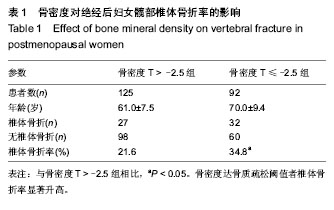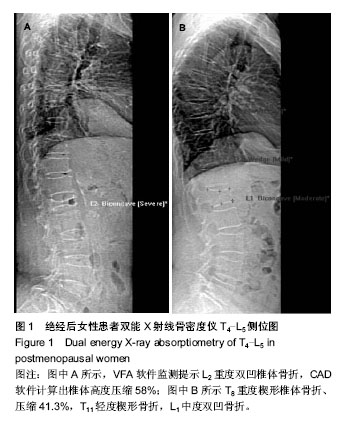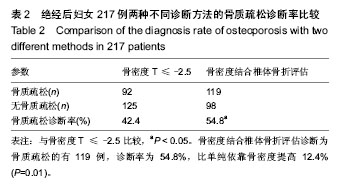| [1]中华医学会骨质疏松和骨矿盐疾病分会.原发性骨质疏松症诊治指南(2011)[J].中华骨质疏松和骨矿盐疾病杂志,2011,4(1): 2-17.
[2]Li YZ, Lin JK, Wang PW, et al. Effect of time factors on the mortality in brittle hip fracture. J Orthop Surg Res. 2014;9:37
[3]Lyles KW, Colon-emeric CS, Magaziner JS, et al. Zoledronic acid and clinical fractures and mortality after hip fracture. N Engl J Med. 2007;357(18):1799-1809.
[4]Siris ES, Miller PD, Barrett-Connor E, et al. Identification and fracture outcomes of undiagnosed low bone mineral density in postmenopausal women: results from the National Osteoporosis Risk Assessment. JAMA. 2001;286(22): 2815-2822.
[5]Johnell O and Kanis JA . An estimate of the worldwide prevalence and disability associated with osteoporotic fractures. Osteoporos Int. 2006;17:1726-1733.
[6]Roux C, Fechtenbaum J, Kolta S, et al. Mild prevalent and incident vertebral fractures are risk factors for new fractures. Osteoporos Int. 2007;18:1617-1624.
[7]Kanis JA, Johnell O, De Laet C, et al. A meta-analysis of previous fracture and subsequent fracture risk. Bone. 2004; 35:375-382.
[8]Sambrook P, Cooper C. Osteoporosis. Lancet. 2006; 367 (9527):2010-2018.
[9]Domiciano DS, Figueiredo CP, Lopes JB, et al. Vertebral fracture assessment by dual X-ray absorptiometry: a valid tool to detect vertebral fractures in community-dwelling older adults in a population-based survey. Arthritis Care Res (Hoboken). 2013;65(5):809-815.
[10]Kanterewicz E, Puigoriol E, García-Barrionuevo J, et al. Prevalence of vertebral fractures and minor vertebral deformities evaluated by DXA-assistedvertebral fracture assessment (VFA) in a population-based study of postmenopausal women: the FRODOS study. Osteoporos Int. 2014;25(5):1455-1464.
[11]Jager PL, Jonkman S, Koolhaas W, et al. Combined vertebral fracture assessment and bone mineral density measurement: a new standard in the diagnosis of osteoporosis in academic populations. Osteoporos Int. 2011;22:1059-1068.
[12]State Council of the People's Republic of China. Administrative Regulations on Medical Institution. 1994-09-01.
[13]Kanis JA, Borgstrom F, de Laet C, et al. Assessment of fracture risk. Osteoporosis Int.2005;16:581-589.
[14]李毅中,庄华烽,林金矿,等.脆性股骨颈骨折的股骨颈皮质厚度和骨密度改变[J].中国骨质疏松杂志,2013,19(10):1018-1021.
[15]庄华烽,李毅中,林金矿,等.脆性股骨颈骨折中股骨颈骨密度及结构参数变化[J].中华老年医学杂志,2014,33(3):282-285.
[16]Klotzbuecher CM, Ross PD, Landsman PB, et al. Patients with prior fractures have an increased risk of future fractures: a summary of the literature and statistical synthesis. J Bone Miner Res. 2000;15(4):721-739.
[17]Lindsay R, Silverman SL, Cooper C, et al. Risk of new vertebral fracture in the year following a fracture. JAMA. 2001; 285(3):320-323.
[18]The european prospective osteoporosis study (epos) group. Incidence of vertebral fracture in europe: results from the european prospective osteoporosis study (EPOS). J Bone Miner Res. 2002;17(4):716-724.
[19]Bow CH, Cheung E, Cheung CL, et al. Ethnic difference of clinical vertebral fracture risk. Osteoporos Int. 2012;23(3); 879-885.
[20]中国健康促进基金会骨质疏松防治中国白皮书编委会.骨质疏松症中国白皮书[J].中华健康管理学杂志,2009,3(3):148-154.
[21]Delmas PD, Langerijt L, Watts NB, et al. Underdiagnosis of vertebral fractures is a world-wide problem: the IMPACT study. J Bone Miner Res. 2005;20(4):557-563.
[22]余卫,姚金鹏,林强,等.胸侧位像椎体压缩骨折诊断忽视原因浅析[J].中华放射学杂志,2010,44(5):504-507.
[23]Li YZ, Cai SQ, Yan LS, et al. Diagnosis of vertebral fracture with DXA image in postmenopausal women. Osteoporos Int. 2014;25(Suppl 2):s197.
[24]Cai SQ. Detection of vertebral fractures in DXA VFA images. Osteoporos Int. 2014;25(suppl 2):s200-201.
[25]Bazzocchi A, Spinnato P, Federica F, et al. Vertebral fracture assessment by new dual-energy X-ray absorptiometry. Bone. 2012;50:836-841.
[26]Diacinti D, Del Fiacco R, Pisani D, et al. Diagnostic performance of vertebral fracture assessment by the lunar iDXA scanner compared to conventional radiography. Calcif Tissue Int. 2012;91:335-342.
[27]Maghraoui A, Mounach A, Rezqi A, et al. Vertebral fracture assessment in asymptomatic men and it’s impact on management. Bone. 2012;50(4):853-857.
[28]Lewiecki EM, Laster AJ. Clinical review: clinical applications of vertebral fracture assessment by dual-energy x-ray absorptiometry. J Clin Endocrinol Metab. 2006;91(11): 4215-4222.
[29]Diacinti D,Guglielmi G, Pisani D, et al. Vertebral morphometry by dual-energy X-ray absorptiometry (DXA) for osteoporotic vertebral fractures assessment (VFA). Radiol Med. 2012;117: 1374-1385.
[30]Mrgan M, Mohammed A, Gram J. Combined Vertebral assessment and bone densitometry increases the prevalence and severity of osteoporosis in patients referred to DXA scanning. J Clin Densitom. 2013;16(4):549-553. |


